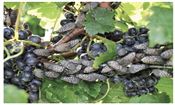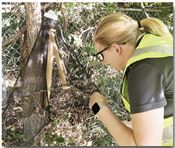Keeping an Eye Out for the Invasive Spotted Lanternfly

Spotted lantern fly feeding on grapevines.
Photo credit: Erica Smyers, Penn State
If one thing has been learned about invasive pests, it's that the first detection is not by a wary entomologist, but instead the watchful eye of a homeowner, park goer, business owner, or a camping enthusiast. It often entails going about your normal workday or taking a stroll in the park and running across something that stands out because you have not seen it before – something so strikingly beautiful it does not seem to belong. This year, the Missouri Department of Agriculture (MDA) has received several phone calls and e-mails from concerned homeowners and businesses in our state whose watchful eyes have found the spotted lanternfly (SLF).
The spotted lanternfly (Lycorma delicatula), is a large planthopper native to Asia and was first detected in the United States in Pennsylvania in 2014. Adults are about an inch long, gray and black in color, and have hind wings with bright red patches. It feeds on the sap of more than 100 plant species, including grape, tree of heaven, apple, oak, walnut, maple and ornamental plants. This bad bug not only has the potential to damage our forests and food supply by feeding on trees and crop plants, but SLF also is a threat to recreation and tourism in our state. The SLF is now found in 14 states, with the most recent find being in Michigan. New infestations are being found hundreds of miles away from the next nearest-known infestation, indicating the pest is hitchhiking with humans. No active populations have been found in Missouri, but the examples provided below demonstrate the risk of SLF entering our state.
In one occurrence, a company contacted MDA at the end of July, after dead SLF nymphs were found in the shrink-wrap surrounding the boxes and pallets of a shipment received from Pennsylvania. Initially, four dead SLF nymphs were found on the shipment, but to date, a total of 15 dead SLF have been spotted. An inspection of the warehouse and vegetation in the surrounding area was completed and no egg masses or live SLF were detected at the facility.
In another occurrence, an e-mail from a trucking company alerted MDA of an adult SLF near the end of September – the first adult SLF specimen for our state. Yikes! Thankfully, it was dead when found. The truck hauling the SLF had traveled to Pennsylvania, Ohio, Indiana and Illinois during September. The SLF was found under the hood of the truck upon return. When evaluated, it was determined the SLF was in the adult stage of its lifecycle when the truck traveled through Pennsylvania, where it was likely picked up.
These occurrences have prompted an inspection of the vegetation on the premises and surrounding the facilities where the dead SLF was found. The MDA team specifically inspects to see if there are any tree of heaven or other host plants located around the businesses. No signs or symptoms of any SLF life stage have been found at this time.
In the reports MDA has received thus far, the SLF was found dead on the premises or no active population was found upon inspection. The recent finds have, however, prompted the Department to place SLF circle traps on high-risk pathways in our state. The Department is thankful Missouri companies are open to SLF inspections and honest about potential sightings. Our team is proud of companies that have been proactive in educating their drivers, maintenance staff, and office employees on the SLF. Training more eyes to spot SLF can help slow the spread of this pest. Please continue to keep an eye out for the invasive spotted lanternfly!
Lifecycle Description
Spotted lanternflies go through five stages of growth after hatching from eggs. The first four stages are called nymphs. The tiny nymphs are initially black with white spots, but eventually develop red areas on their bodies. Adults are about an inch long, gray and black in color, and have hind wings with bright red patches. Adult spotted lanternflies are present from July through December. Egg masses of 30-50 eggs overwinter and hatch in the spring.
How can you help?
Early detection is key. Inspect your trees and plants for signs of this pest, particularly at dusk and at night when the insects tend to gather in large groups on the trunks or stems of plants. Inspect trees (in particular, tree of heaven), bricks, stone or other smooth surfaces for egg masses.
If you think you have found spotted lanternfly, follow these steps:
- Take a picture.
- Collect the insect.
- Report your find. Email a photo and the location to the Missouri Department of Agriculture:plantpest@mda.mo.gov ∆

Rosalee Knipp, MDA Forest Pest Program Coordinator, places a spotted lantern fly circle trap onto a tree.
